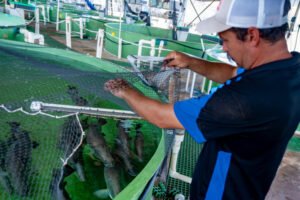Wednesday, 17 December 2025
Ever After Foods and Bühler partnership scaling cultivated meat
Eyal Rosenthal, CEO of Ever After Foods In recent years, the cultivated meat industry has made significant progress in revolutionising protein production. A crucial development in this evolution is the…

Eyal Rosenthal, CEO of Ever After Foods
In recent years, the cultivated meat industry has made significant progress in revolutionising protein production. A crucial development in this evolution is the collaboration between Ever After Foods and Bühler, which focuses on addressing the major challenges of scaling cultivated meat production. By combining Ever After Foods’ innovative, purpose-built production system with Bühler’s expertise in food manufacturing, this partnership aims to significantly reduce production costs and make cultivated meat a commercially viable option. Eyal Rosenthal, CEO of Ever After Foods, shared his insights with Nuffoods Spectrum about the collaboration’s goals, technology, and potential impact, discussing how it could reshape the global food landscape and contribute to a more sustainable and secure food system.
What led to this collaboration between Ever After Foods and Bühler?
This partnership was born out of a shared vision to bring cultivated meat to scale. Current biotech and pharma equipment simply isn’t built for food production—it’s expensive, inefficient, and limits commercial viability. Ever After Foods developed a purpose-built, food-grade system designed for mass production, and Bühler, a global leader in food manufacturing technology, is the ideal partner to scale it. Together, we’re solving one of the biggest bottlenecks in cultivated meat: making it commercially viable.
How does this partnership set itself apart from other initiatives in the cultivated meat space?
Unlike other initiatives that try to force biotech solutions into food production, we’ve engineered a system specifically for cultivated meat at scale. Our technology delivers a tenfold reduction in production costs, while Bühler’s expertise in food processing ensures efficient, large-scale manufacturing. This isn’t just an R&D experiment—it’s a commercially viable solution designed to transform the industry.
Can you share details on the patented production system and how it enables a tenfold lower production scale compared to existing technologies?
Our column-based bioreactor is a game-changer. Instead of growing cells in liquid, we use plant-based scaffolds to create a dense, 3D structure, enabling high-yield tissue growth. While traditional bioreactors produce just 2-4 per cent cultivated meat per litre, our system achieves over 40 per cent, meaning a 200L reactor can generate more than 80kg of product—a 20x improvement. This breakthrough slashes production costs, shortens R&D cycles, and makes cultivated meat commercially viable.
What challenges in the global food system does this technology aim to address?
We’re tackling three major crises: food security, sustainability, and supply chain resilience. Cultivated meat drastically reduces land and water use, cuts emissions, and eliminates supply chain vulnerabilities tied to traditional livestock. By enabling local production at scale, we’re future-proofing the protein supply for a growing world population.
How do you foresee this innovation influencing the broader food industry and traditional meat production?
This isn’t just an innovation—it’s a paradigm shift. Cultivated meat is no longer a niche science project; it’s a scalable, cost-effective reality. Just like electric vehicles reshaped transportation, our system is set to disrupt the way the world produces protein. Food companies that embrace this change will lead the future of meat production.
What role do you see cultivated meat playing in food security and sustainability efforts worldwide?
Cultivated meat offers unprecedented efficiency: up to 99 per cent less land, 80 per cent less water, and a fraction of the emissions compared to conventional meat. By moving production from farmland to food hubs, it reduces supply chain risks and ensures a steady protein supply, no matter the geopolitical or environmental challenges.
What are the key barriers to scaling cultivated meat production, and how does this system help overcome them?
The biggest hurdle has been the wrong equipment—cultivated meat companies have been forced to use pharma-grade bioreactors that aren’t built for food. Cells don’t thrive in high-shear stirred tanks, leading to low yields, high costs, and long R&D cycles. Our packed-bed bioreactor eliminates these inefficiencies, increasing yield by 20x and making large-scale production financially viable.
What types of food producers are you targeting with this solution?
We work with cultivated meat companies seeking to scale up faster and cheaper and large food companies looking for turnkey cultivated meat solutions under their brands. Our technology is species-agnostic, so we’re helping partners across beef, poultry, seafood, and beyond.
How does this technology contribute to making cultivated meat more affordable for consumers?
The key to affordability is efficiency. Conventional cultivated meat processes yield just 4-8kg of product from a 200L bioreactor, while ours delivers over 80kg. This tenfold increase slashes costs, making cultivated meat a mainstream option rather than a premium novelty.
What are the next steps in bringing this system to market?
We’re already working with leading cultivated meat players and major food manufacturers, proving our system’s scalability. With Bühler, we’re taking the final step: commercial-scale production. The pieces are in place—now it’s about execution.
Do you anticipate any regulatory challenges, and how do you plan to navigate them?
Our plant-based scaffold is fully compliant with food regulations, meaning no additional regulatory hurdles for our partners. This eliminates one of the biggest roadblocks to commercialisation.
Where do you see the cultivated meat industry in the next five to ten years?
Expect industry consolidation and strategic alliances—cultivated meat isn’t a solo game; it’s about partnerships. With the right scaling solutions, commercially viable products will be on shelves within 5-7 years. Companies that embrace efficiency and collaboration will define the future of meat.
Shraddha Warde
Shraddha.warde@mmactiv.com
Technology
Nfinite secures funding to scale up breakthrough paper packaging solution
Dec 17, 2025 | Company News
Silal–Square Roots partnership uses AI to boost sustainable food production
Dec 17, 2025 | Company News
Food Testing
Australia’s Humpty Doo Barramundi farm to achieve ASC certification
Dec 08, 2025 | Australia
SFDA and Turkish Halal Accreditation Agency forge strategic partnership
Dec 05, 2025 | Food
Fish freshness easily monitored with a new sensor
Dec 04, 2025 | Food Safety and Testing
More Popular
Nfinite secures funding to scale up breakthrough paper packaging solution
Dec 17, 2025 | Company News
Silal–Square Roots partnership uses AI to boost sustainable food production
Dec 17, 2025 | Company News
Korea's Samson Food broadens seafood portfolio with hwangto salt-based products
Dec 17, 2025 | Company News






